There’s a very good reason I returned to southeast Texas last week, aside from the “warbler-tanager fever” that is. The High Island–Bolivar Peninsula area provides a wealth of different birds to photograph at locations ranging from the beach to the freshwater wetlands to the woodlands and fields of High Island. There are still wintering birds in early May, and many have molted into their colorful alternate plumage; there are resident birds that likewise are in their best colors and many are concentrated at prime nesting locations. And then there are the migrants that create a situation in which a variety of birds can literally fall out of the sky and perch before you in all their spring glory.
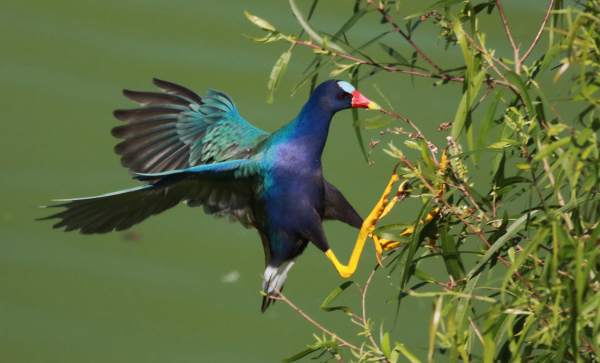
Trying to photograph a Purple Gallinule produced poor results during the first 4 opportunities, which were few and far between one another over a number of days. But the last photo in the fifth series of photos turned out to be especially impressive as the rainbow bird was landing on the edge of some willows. The light intensity and direction was as good as you could hope for, and the pre-settings of ISO 400 and f6 with a shutter speed of 1/2500 combined for a memorable action photo. In retrospect, the f6 aperture probably should have been set at f8, but the settings obviously worked out well.
Birds range from large wading birds with broad wingspans to medium and small shorebirds and terns, to the variety of songbirds that come and go on a whim. Some are pretty sedate, while others are overly wary, and the songbirds tend to be in a rush and ever-moving. At the same time, the different habitats provide varied photo settings ranging from sand or gravel to grasses, underbrush, and trees that are all but fully leaved. But during spring, weather can be the biggest factor, especially if you rely on the light of the sun to illuminate your photos, like I do. And an exciting fallout of songbirds often happens during or just after a rain event, so you need to adapt as best you can in the field.
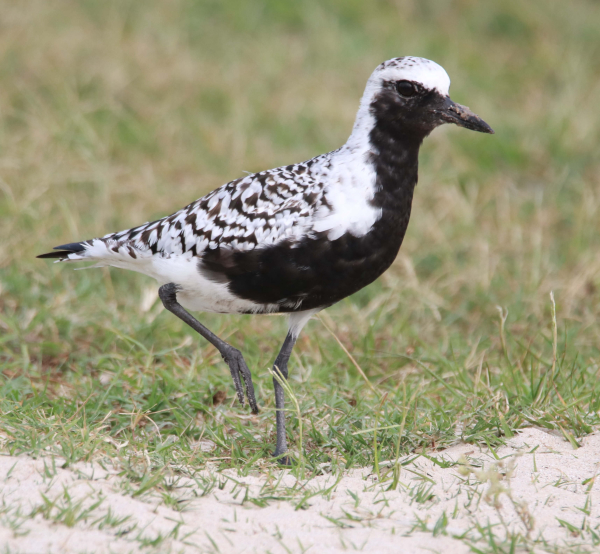
Ready to return to the Arctic tundra, this impressive Black-bellied Plover in full alternate plumage provided an opportunity to photograph it as it hunted large insects in the cover of short grass. The overcast sky provided enough light to show the color highlights of the bird well, while eliminating any shadows. The settings were ISO 400, f6, 1/500.
When you’re on a birding trip, there is an added element in that you need to take advantage of the time you have at a given location, which may be a few days, a few hours, or a quick stop, depending on the situation and your plans. To that travel element, add the weather factor, and more important the sunlight factor, and you hope for the best and make the most of the rest. The sunlight factor not only includes if there is sunlight, but also what direction it’s coming from, and at what angle in the sky the sun is beaming from. As you know, optimum sunlight comes from behind you so it illuminates your subject at a preferred angle of 30 to 60 degrees above the horizon. All that is fine, but you will need to do a fair amount of compromising day to day, bird to bird on a photo trip.
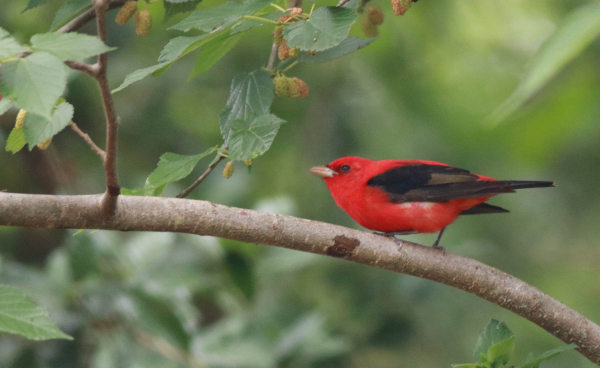
Photographing at a tree filled with the activities of Scarlet Tanagers and other birds under heavily overcast conditions required increasing the ISO to 1600, which produced some areas that show the graininess of the image. By cropping the photo to include a larger area of the setting, this brightly colored male’s image was relatively sharp and the grainy background was less obvious. The aperture was f5 and the shutter speed 1/400 of a second in the low light conditions.
|
In some cases, overcast conditions can be helpful, like when photographing sandpipers, plovers, and terns on the beach, and the sunlight is coming from the wrong direction and angle. The overall colors of the birds might be a bit muted in that light, but they also lack distracting shadows that can ruin or detract from an image. Same thing in the woods, where shade and the recesses of thick vegetation make photographing foraging songbirds difficult – unless they move to the edge of a tree or shrub where the lighting is better.
Songbirds also add that fast-moving darting and probing quotient that is hard to keep up with at times, much less to try to anticipate their next move or position. But we try, we do our best, and we revel at the opportunities presented. Bird photography is rarely easy or predictable, and it’s always a test for you and your equipment, but it’s a thrill whether you win or lose in a photo duel, and you move on to the next prospective bird to photograph.

After initially finding this white morph Reddish Egret prancing after fish across a small shallow wetland with its wings partly spread, it was surprising to see the egret take such a stoic pose when being photographed, and it did not move for some time. Eventually a breeze pushed its elongated nape feathers forward like a crown to provide a unique image. The overhead sun created some shadowing on the white plumage, but it also brightened the colors of the bare facial skin and its bill (ISO 400, f9, 1/1600).
Tech Options
But as diverse as the surroundings, weather, and birds are, we need to be ready to make a few technical adjustments and try to find the best camera settings under the variety of conditions that come our way. With the sun out and in the optimum position, I use my standard ISO 400 setting with a middle of the road aperture of f8. However, with small songbirds it’s usually not necessary to have a wide depth of field, and it’s often better to try to blur the background to emphasize the bird. So I dial the aperture to an f6 or even f5, which also provides a little faster shutter speed under lower light conditions.
When conditions are overcast, I dial my ISO from 400 to 800 to help brighten the photos, but I don’t like to use an ISO of 1600 or higher, because they creates a grainy pattern on photographs. Even so, you do what you need to do under difficult or extreme lighting situations, and when in doubt, do a little first-hand research and see what works for you and what doesn’t – any option is worth a try, and if it works, you’re richer for the effort.
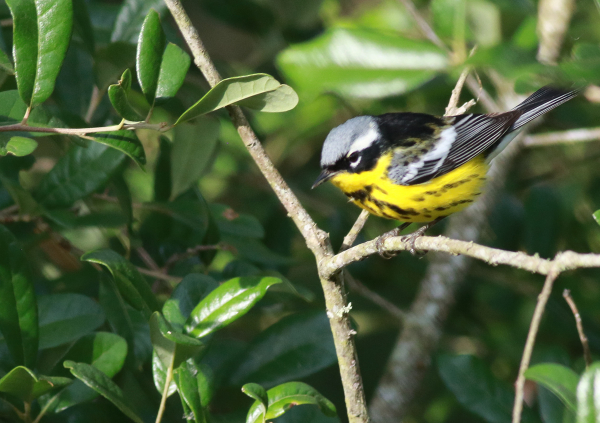
The best warbler photo of the week was not a standout, but it is indicative of just how hard it is to get good quality photos of the little dynamos as they move quickly among the leaves and branches of trees and shrubs, usually overhead, and often in low light conditions. The settings for this Magnolia Warbler photo were an ISO of 800, an aperture of f6, and a shutter speed of 1/640 of a second.
A Variety of Examples
This week I thought I’d share a variety of photos – some good, some not so good, some more documentary than anything else – to provide some examples of the variety of birds, habitats, lighting, and camera settings that I experienced during the past week in southeast Texas. And as you photograph through the spring migration and pre-nesting periods and beyond, enjoy the photo options that unfold before you, make changes in your settings as you deem necessary and as conditions change, and spend as much time as you can using your camera in the pursuit of new bird phots. It’s a great time of the year to be a birder, and bird photography is one of the great pleasures of birding!
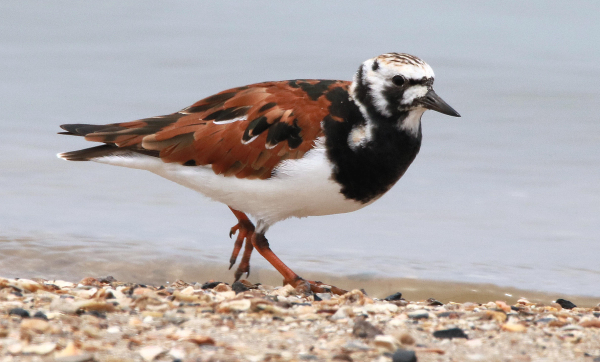
When photographing ground-based birds, it’s nice to get on their level to show their perspective and draw observers into the scene. This Ruddy Turnstone in brightly colored alternate plumage is enhanced by a uniform water background and the coarse beach sand that shows its habitat choice. Overcast conditions eliminated shadows but the colors could have been enhanced by early morning or late afternoon sunlight (ISO 400, f8, 1/1600).
Article and photographs by Paul Konrad
Share your bird photos and birding experiences at editorstbw2@gmail.com